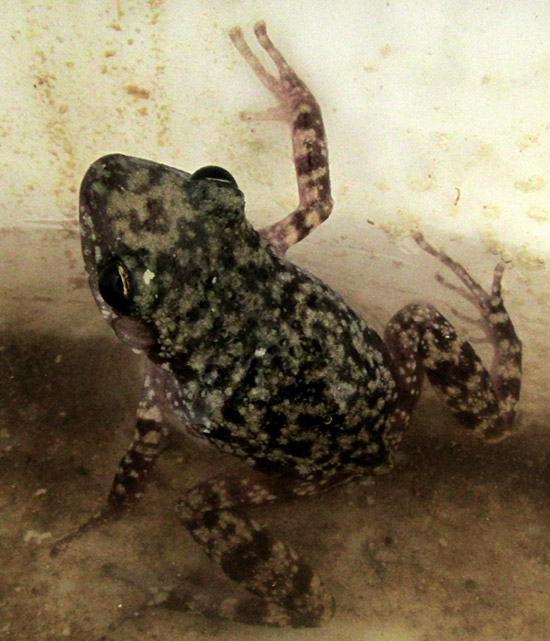Excerpts from Jim Conrad's
Naturalist Newsletter
entry dated May 9, 2023, issued from near Tequisquiapan, elevation about 1,900m (6200 ft), Querétaro state, MÉXICO
(~N20.55°, ~W99.89°)
GREENHOUSE FROG, PROBABLY

After months without rain, finally one afternoon enough fell to pool in the bottom of an empty 19liter (5gallon) paint bucket, as seen above, with a frog found there the next morning. The bucket had been midway down a flight of steps leading into the walled-in backyard of a house at the edge of a small community surrounded by overgrazed scrub and small ranches. By around 9AM the frog had taken position on the bucket's vertical side:

No field guides exist to help identify frogs of this upland part of central Mexico, so getting a name amounts to doing image searches on the Internet using such keywords as "ranas Querétaro" -- ranas being Spanish for frogs.
Soon it became clear that our bucket visitor was a member of the genus Eleutherodactylus, a group of frogs in English mostly referred to as rainfrogs, chirping frogs and robber frogs. However, over 200 species in that genus currently are recognized, all native to warmer parts of the Americas, from the southern US through most of South America. Also, some have become invasive elsewhere.
Wikipedia's Eleutherodactylus page tells us that many species of that genus may occur on only one island or in only one or a few localities, though sometimes in these limited areas they're found at very high densities. I read that certain Eleutherodactylus species are so similar that confusion in taxonomic classification has arisen.
In all Eleutherodactylus species, instead of the female laying eggs which hatch into tadpoles that develop into adult frogs, females lay eggs from which small froglets emerge, with no tadpole stage. Mainly adults feed on arthropods.
Numerous Internet pictures appeared to match our frog, but they were labeled with a variety of names. Probably the most frequent name applied was Eleutherodactylus guttilatus, the Spotted Chirping Frog. Another was Eleutherodactylus nitidus, the Shiny Peeping Frog. Both species occur in our general area, but both are said to inhabit various forest types, with no mention of human-associated environments.
One set of images matching our pictures was labeled Eleutherodactylus planirostris, the Greenhouse Frog, native to Cuba, the Bahamas and the Cayman Islands. Looking up that species, I found that Greenhouse Frogs have become invasive, now documented from Florida to China, and that's including Mexico, where it's mostly reported from the Yucatan Peninsula and the Veracruz Gulf Coast. Pictures of this species often show it in such situations as bucket bottoms and on bathroom floors. One picture perfectly matching our frog and photographed only 7kms from here, but labeled as Eleutherodactylus guttilatus, was annotated with the remark, "Mi mamá encontró a esta rana en su lavabo" -- "My mama found this frog in her sink."
In the end, I've figured out three things: First, during image searches on the Internet, plenty of misidentified thumbnails turn up; second, probably our frog is ELEUTHERODACTYLUS PLANIROSTRIS, and; third, the Greenhouse Frog enjoys a greater presence in Mexico than currently thought.
Greenhouse Frogs show an overwhelming preference for lowland heat and humidity. However, our frog is found in a regional center for greenhouse production of vegetables, with several greenhouses within easy walking distance. If Greenhouse Frogs like greenhouses, they'll easily find congenial lodging here.
Identification of Greenhouse Frogs is complicated by their exhibiting two pattern phases, as explained on AnimalDiversity.Org's Eleutherodactylus planirostris page. That website tells us that the "recessive mottled phase" displays a dark brown and a tan coloration, often with a faint V-shaped band on the back and a band between the eyes, while the "dominant, striped phase" shows two light stripes starting at the eyes and running along the sides to the back of the frog. We have the recessive mottle phase.
One field mark worth noting is that along the lower sides -- just visible in our top photo -- there's white stippling on a gray to white background.
The AnimalDiversity.Org website also reports that Greenhouse Frogs have been documented laying eggs in the soil of potted plants. The property owner where our bucket frog was found frequently buys potted plants for his backyard.